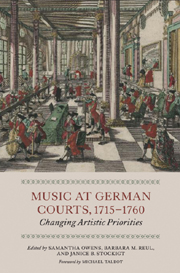Book contents
- Frontmatter
- Contents
- List of Tables
- Foreword
- Preface
- Editorial Notes
- Notes on Contributors
- List of Abbreviations
- 1 ‘Das gantze Corpus derer musicirenden Personen’: An Introduction to German Hofkapellen
- KINGDOMS AND ELECTORATES
- DUCHIES
- 6 The Court of Württemberg-Stuttgart
- 7 The Court of Saxony-Gotha-Altenburg
- 8 The Courts of Saxony-Weißenfels, Saxony-Merseburg, and Saxony-Zeitz
- PRINCIPALITIES AND PRINCE-BISHOPRICS
- LANDGRAVIATES AND MARGRAVIATES
- Index
6 - The Court of Württemberg-Stuttgart
from DUCHIES
Published online by Cambridge University Press: 12 September 2012
- Frontmatter
- Contents
- List of Tables
- Foreword
- Preface
- Editorial Notes
- Notes on Contributors
- List of Abbreviations
- 1 ‘Das gantze Corpus derer musicirenden Personen’: An Introduction to German Hofkapellen
- KINGDOMS AND ELECTORATES
- DUCHIES
- 6 The Court of Württemberg-Stuttgart
- 7 The Court of Saxony-Gotha-Altenburg
- 8 The Courts of Saxony-Weißenfels, Saxony-Merseburg, and Saxony-Zeitz
- PRINCIPALITIES AND PRINCE-BISHOPRICS
- LANDGRAVIATES AND MARGRAVIATES
- Index
Summary
THE YEARS 1715 TO 1760 represent a rather unsettled period in the musical life of the south-west German court of Württemberg, based primarily at palaces in Stuttgart and Ludwigsburg. Nevertheless, the surviving archival documentation, held by the Hauptstaatsarchiv Stuttgart and covering the reigns of three successive dukes – the Lutheran absolutist Eberhard Ludwig (r. 1693–1733), his cousin, the Catholic convert Carl Alexander (r. 1733–37), and the latter's son, the undeniably extravagant, opera-loving Carl Eugen (r. 1744–93) – illuminates many of the central themes of Western musical history. These include the emergence of the orchestra, the rise in the importance of chamber music, and the increasing numbers of Italian musicians employed in German Hofkapellen during the eighteenth century.
Described by Peter H. Wilson as ‘one of the weaker middle ranking territories within the Empire’, the rulers of the duchy of Württemberg nevertheless made significant efforts to keep abreast of the latest cultural trends. The final decades of the seventeenth century therefore witnessed an increasing awareness on the part of the court of the fashionable French style, resulting in the employment of French musicians, festive performances of large-scale Singballette (modelled loosely on the ballet de cour), the adoption of new baroque woodwind instruments, and the institution of a Lullian string band – all of which helped to prepare the way for the eventual appearance of the orchestra at the court.
- Type
- Chapter
- Information
- Music at German Courts, 1715–1760Changing Artistic Priorities, pp. 165 - 196Publisher: Boydell & BrewerPrint publication year: 2011



